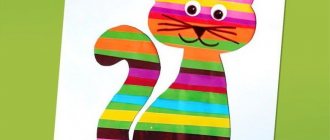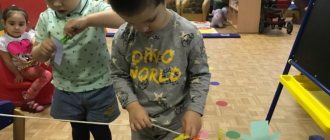When to introduce your child to music
You can start getting acquainted with music during pregnancy. It has been noted that expectant mothers who prefer classical music feel better, calmer, and more balanced than women who avoid such pastimes. It's good if during pregnancy you find 10-15 minutes a day to enjoy a piece of music. Your good mood will create comfortable conditions for the development of your unborn child.
After birth, you can turn on music in the baby’s room for the first time the next day. It is recommended to choose to listen to a calm classical composition for 5-10 minutes while the baby is awake.
The singing of mother and other adults plays a significant role in musical development. Various lullabies and children's songs develop the child's hearing and create a comfortable atmosphere.
Further acquaintance with music occurs through daily listening to classical and children's works. At 6 months, you can buy your child a set of toy or real instruments to develop the ability to distinguish sounds. It is good to offer classes to develop the ability to distinguish the sounds of different objects, to offer to create their own musical “works” with pot lids and rattles.
By 12 months, when the child learns to walk, you can begin to teach the baby to dance. Simple movements to the beat of the melody are good for the development of coordination, hearing, and the vestibular system.
As soon as the first words appear in the child’s speech, invite him to sing along and finish familiar songs. Gradually seeing how you enthusiastically listen, sing, and dance to the music, the child will become familiar with this type of art and form his own taste.
Closer to the age of 3, children begin to show interest in certain types of music and ask to play their favorite compositions. It is recommended to listen to the opinion of your son or daughter and allow him to listen to what he likes. Along with the emergence of interest in a certain genre, it is good to show and tell what instruments exist and how they sound.
At the age of 4-5, introduce your son or daughter to famous composers and their works. Teach your child to think about the emotions that the author felt when writing the melody, and come up with a plot suitable for the sound.
At the age of 5-6, you can attend a concert or opera, introducing your child to the profession of a musician or singer.
The musical development of a child depends on the desire of adults to introduce their son or daughter to art. There is no need to read long and boring lectures on musical literature, just teach your baby to feel the melody and express his inner world with it.
We have prepared a selection of works for you to listen to with your children. You can use the suggested lists or create your own that suits your tastes and preferences.
What to suggest your child listen to from classical music:
- A. Vivaldi “The Seasons”.
- W. A. Mozart:
- Sonata No. 11;
- Alla Turka;
- “Little Night Serenade”;
- “Symphony No. 40”;
- “March of the Priests from The Magic Flute”;
- "Turkish March".
- P.I. Chaikovsky:
- "Nutcracker";
- "Swan Lake";
- “Children's Album”.
- L. V. Beethoven:
- “To Eliza”;
- “Ode to Joy”;
- "Moonlight Sonata";
- “Symphony No. 5 in C minor”;
- "Pathétique Sonata"
- F. Schubert:
- Ave Maria;
- “Fantasy in F minor for piano four hands”;
- "Third of Six Musical Moments."
- I. Albeniz “Spanish Suite”.
- I.S. Bach:
- “Prelude and Fugue No. 1 in C major”;
- "Prelude No. 1"
- A.P. Borodin "Prince Igor".
- I. Brahms:
- "Hungarian Dance No. 1";
- "Symphony No. 3".
- J. Bizet "Carmen".
- K. Debussy “Little Suite”.
- I. Strauss “On the beautiful blue Danube.”
The list of classics for young children to listen to is endless. The main thing is to be guided by your own musical tastes when compiling a collection and create your own unique list for the development of your child.
What to suggest your child listen to from children's songs:
- “Who is grazing in the meadow?” (from the almanac collection “Merry Carousel No. 5”);
- “Two cheerful geese” (from the anthology collection “Merry Carousel No. 2”);
- “Antoshka” (from the film “Antoshka”);
- "Dance of little ducks";
- "In the grass Grasshopper sat";
- “Clouds” (from the film “Shake, Hello”);
- “Chunga-changa” (from the film “Katerok”);
- “Blue Car” (from the film “Cheburashka”);
- “Song of the Lion Cub and the Turtle” (from the film “How the Lion Cub and the Turtle Sang a Song”);
- “Smile” (from the film “Little Raccoon”);
- “Song about Summer” (from the film “Father Frost and Summer”);
- “Cheburashka’s Song” (from the film “Cheburashka”).
You can add your favorite cartoon songs to this list. The main thing is to sing them to your child with soul and joy, smile and sing along while listening.
What sounds of nature should I include for my child to listen to?
- Sounds of the rain;
- Storm;
- Surf;
- Sounds of the forest;
- Birdsong;
- Animal voices;
- Sounds of the city.
Musical development is the ability to distinguish and understand different sounds surrounding a child, the ability to feel the beauty of the surrounding world. In addition to classical works and children's songs, sometimes include sounds from different parts of the world and natural phenomena. While listening to a certain sound, explain what the baby hears and who or what makes that sound.
What is rhythm
Rhythmics is the performance of simple dance movements to music. Rhythmic classes are considered the child’s first conscious steps in dancing. Children become familiar with such concepts as “fast” and “slow”, “loud” and “quiet”, “fun” and “sad”, and learn to move to musical accompaniment. Unlike other musical and physical activities, rhythmics does not focus on technique or physical development of the child. The main emphasis is on the development of coordination, the ability to hear music and perceive rhythm (alternating sounds and pauses).
When planning rhythm classes, it is important to take into account the age characteristics of children.
Children 3-4 years old have poorly developed coordination, they have poor body control and do not understand how to connect their movements with music. The main task of the music director is to help the child develop coordination of movements.
By the age of five, a child can already coordinate not only his own actions, but also work in pairs. He has a good imagination and can repeat a combination of several movements at a time.
At the age of 7, the child already has full control of his body. He can express emotions and feelings through movements, control the quality of performance, and come up with his own movements and combinations.
It is important for the teacher to select exercises for classes in such a way that they correspond to the age of the students.
Advice for parents involved in children's music education
The development of children's musical abilities directly depends on the attitude of adults towards music. Fill your home with love and respect for classical compositions and children's songs, and your baby will be happy to get acquainted with this type of creativity.
To make dating easy and fun, remember a few simple rules:
- The attitude of adults towards music is an example for a child. If you do not like and do not listen with pleasure to the compositions offered to your baby, then he will not be interested in them.
- Immerse yourself in the world of music with your son or daughter. Don’t be shy about your emotions and feelings, talk about them directly. Show how you can discover your inner world through music, tell us how you perceive the melody, how you see the composer’s intention.
- Laugh, be surprised, be sad with your baby.
- Learn to distinguish different sounds on simple objects. Let your child knock on the floor, shake all sorts of objects, offer to play musical instruments independently and with you.
- Show how to listen to music and completely immerse yourself in the process. It is ideal to create a music listening ritual where the whole family gets together at a certain time to listen and dance;
- Do not miss the opportunity to develop knowledge about music, it will improve your child’s perception and understand many complex disciplines faster and easier;
- Don't force your son or daughter to study or listen to music if the child doesn't want to. But don’t put off classes until later if your child craves them. Be patient and forgiving with your baby. Don't be upset if he still has flaws and errors in execution. By practicing with joy and interest, your baby will gradually master all the possibilities that nature has given him.
- Do not think that your child does not have hearing, voice or plasticity. Each of these skills is trained and acquired through practice and love.
Music education is a long process that combines a large variety of knowledge and skills. Your desire to raise a kind, intelligent and sympathetic person can only be realized through constant work on self-improvement. If you develop yourself musically, your baby will happily repeat after you and will definitely master all the necessary knowledge.
If you liked the article, please share a link to it
How to tell about notes?
Before you introduce your child to notes, you need to explain to him what they are.
Notes are recorded sounds. Just as we write our speech in letters, so music is written in notes. There are a huge variety of notes: both high and low, but they are all divided into 7 basic ones, which everyone knows: do, re, mi, fa, salt, la, si.
The notes live on a musical staff, which consists of 5 lines. The notes can be located either directly on these lines, or between them, they can also be under and above the lines, and on additional lines that we draw above or below.
Draw a staff of music on a large sheet of paper and write notes in a row on it (you can color them in different colors). Then sing them all together with your child.
To make your child interested in learning notes, you can show him a cartoon about the notes “Do Re Mi.”
A start has been made - the child has a general understanding of notes. Only after showing interest in notes can you start learning them seriously (it’s better to do this on another day).





